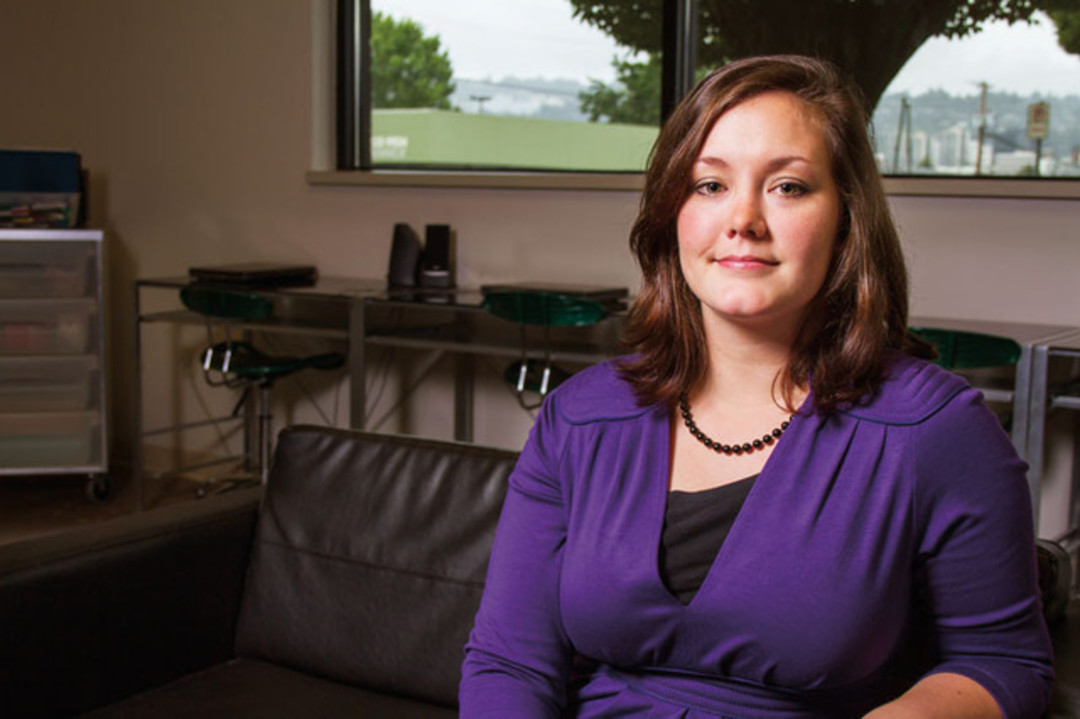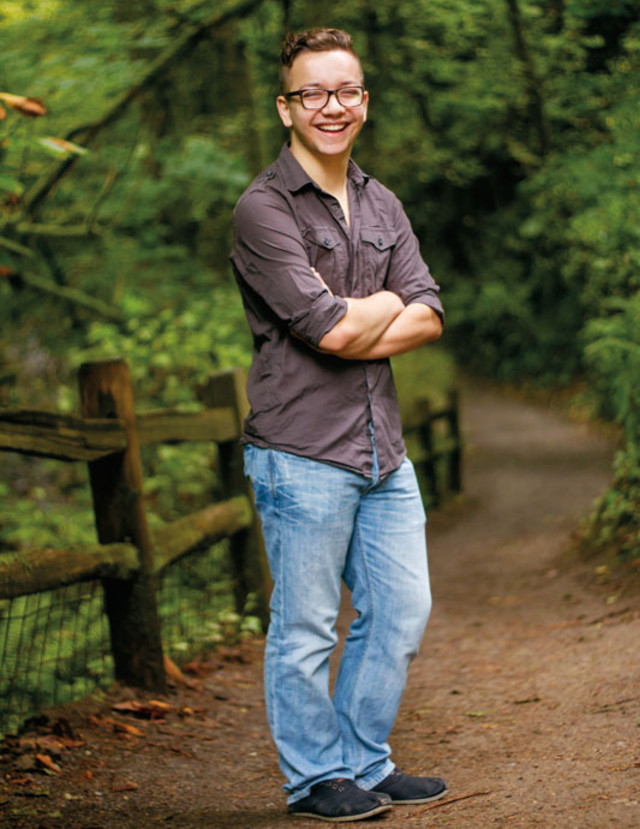Emerging Leader
2014: Anna Allen of NAYA
For most of Anna Allen’s teenage years, the now-25-year-old member of the Shoshone-Bannock tribe was homeless, avoiding an abusive father while her mother was in rehab for alcoholism. She slept under the Burnside Bridge, stole food, and sold drugs to survive. By her junior year, she had dropped out of high school.
“I had to figure out a way to turn these horrific experiences into a better life,” she remembers. “I knew if I didn’t change I would end up dead.”
At 16, Allen and her mother began working with the Native American Youth and Family Center (called NAYA), a Northeast Portland organization that provides free meals, bus tickets, social events, and education for Native American families. “I had never received support services and didn’t even know that a place like NAYA existed,” says Allen.
When she was 17, Allen returned to night school to earn her GED with NAYA’s help. Seven years later, she was selected for Oregon LEAD, NAYA’s yearlong program to develop leaders in indigenous communities. After she graduated in June, she became lead development coordinator for NAYA.
This year, Allen also spearheaded the Young Native Ambassadors Program (YNAP), which received a $100,000 grant for cultural workshops and courses in résumé-writing and public speaking. “My childhood prepared me for this job,” says Allen of her journey from the streets. “I used to worry about how I was going to eat and where I would sleep. Now, my challenges are how can I make this program better or how can I be a better leader.”
Inspired by our amazing Light a Fire winners? Find out how to give back to
Portland's best nonprofits with our Guide to Giving!
2013: PAMELA BUTLER

FOR MUCH OF HER YOUTH, Pamela Butler had little control over her world. Her mentally ill mother and stepfather carted her around the country until the Oregon Department of Human Services removed her from their custody and put her into Oregon’s foster-care system at age 7. Over the next 11 years, she lived in eight different homes, enduring not only abuse but the feeling, endemic to the system, of utter powerlessness.
“You’re just kind of floating,” she says, “like you’re no one’s child.”
“Getting legislation passed in Salem is an arduous process,” says Chip Shields, a state senator who sponsored an OFYC-backed bill this year to create a foster youth “bill of rights.” “Pamela brought together Oregon’s most vulnerable population and empowered them with the tools they need to advocate for themselves.”The anxiety Butler felt growing up helps explain the potency to which she brings to her work today. As the director of Oregon Foster Youth Connection, a program of the child-advocacy nonprofit Children First for Oregon, Butler leads foster youth in lobbying for child-welfare reforms at the state legislature. Since founding the program in 2008, Butler and her crusaders-in-training have scored a perfect record: four out of four bills. These have not been small asks: in 2011, for instance, OFYC pushed through legislation allowing foster-care alumni to attend state colleges for free.
Butler is also pushing child-welfare reform beyond Salem, collaborating with Oregon’s senators on federal issues and working on national committees. The erstwhile ward of the state hasn’t, however, forgotten where she came from—and wouldn’t want to.
“If I’m in a room with a bunch of administrators, no one can say, ‘No, that’s not how things happen,’” she says. “I’ve been there: I’ve got my stories; I’ve got the youth’s stories; I’ve got the research. It’s a powerful combination.”

2013: ALEX HORSEY

Image: Ashley Anderson
THE YOUNG, an old adage claims, are the leaders of tomorrow. Alex Horsey, for one, isn’t waiting.
The 2013 Wilson High graduate has held board and leadership positions with groups ranging from Friends of Outdoor School to the Oregon Lutheran Youth Organization. As a high-school junior, he founded Project Believe in Me, an initiative that fights bullying and bullying-related suicide by, among other things, publishing open letters from former victims on its website.
Horsey came out of the closet at age 12 and is no stranger to the prejudice of children and the consequent feelings of isolation and hopelessness. But it was the media storm around a string of suicides several years ago that incited him to step up. “What scared me was that the only things that were in the media were people committing suicide due to bullying,” Horsey says. “I was worried that would create this false assumption that that’s the only way out.”
As he moves on to Portland State University to study community development, Horsey is working to keep high school students involved in Project Believe in Me leadership. “There’s so much change we can create right now,” he says. So Horsey created a website, printed fliers, and reached out to community groups and national partners. The letters he received from other bullied youth offer glimpses beyond the darkness. “Some days are going to be horrible, but ... there are people, near and far, who are waiting to love you,” one promises. “I was you. I am you,” says another.
2012: Chabre Vickers
When most people seek salvation, they don’t look in a barbershop. They go to church. Chabre Vickers went to both. In need of more exceptional African American men to mentor at-risk youth in Portland, the director of community relations and diversity programs for Big Brothers Big Sisters Columbia Northwest went to the places where she knew she’d find them. At the barbershops, she’d hire a DJ and serve some food, all the while bending ears about the importance of volunteering. “Yes, I’m a talker,” she admits with a smile. She’s also persuasive: in one church event alone last year, she signed up 85 new volunteers for the Big Brothers Big Sisters—a personal best. Winning more recruits for her organization, which mentors up to 3,000 kids each year, is but one of the brag-worthy feats for Vickers, who might be considered one of Portland’s superconnectors. She also holds leadership positions in Young Professionals of Portland, sits on the board of environmental justice group Groundwork Portland, and is on the steering committee of the Portland African American Leadership Forum. Through her meetings with Nike’s Black Employee and Friends Network, Big Brothers Big Sisters has received more than $220,000 in donations. What’s her secret? “I just strive for authentic relationships,” Vickers says, “and those relationships feed into my ability to do my job better.”
2011: Mission: Citizen
They may not have been old enough to vote, but that didn’t stop six Lincoln High School students from helping others earn their right to pick our political leaders. Inspired by their rigorous study of the US Constitution for a national civics competition, the students formed Mission: Citizen in 2009 to help immigrants pass their naturalization tests and become American citizens. Since then, dozens of Lincoln students have taught free eight-week courses to about 60 immigrants. Some, like Chan Chanthakoun, an immigrant from Laos, passed on the first try. Others, like Beatrice, a recent class attendee from Rwanda, proved teachers themselves. Beatrice struggled with the concept of political free speech, which Mission: Citizen cofounder Louis Wheatley says taught the Lincoln students not to take the rights afforded to Americans for granted. Mission: Citizen garnered grant money from Community 101/PGE Foundation to expand the program and help even more immigrants … and students. “Their stories help push us to help them achieve a better life,” says Wheatley, a major in history and romance languages at Dartmouth. “We’re thrilled and honored to be part of that journey.”
2009: Matt Morton
Only 34 percent of Native American students in Portland Public Schools graduate within four years. It’s a number that Matt Morton—board chair for the Native American Youth and Family Center, or NAYA, a 40-year-old advocacy and resource center for Portland’s nearly 38,000 Native Americans—takes personally. “When I come home to my wife and 10-month-old son,” says the Native American from the Squaxin Island Tribe, “I see the importance of my work and the impact it will have on the next generation.” Impact is exactly what Morton is determined to create. With the help of a committed board of directors, a talented staff, and a vibrant community, Morton is confident in his position as a strategist and community leader. “It’s not hard to feel empowered when your community is a part of the decision-making process,” says Morton, who participates in regular meetings with elders and other community members. “I’ll do anything it takes to give them what they need and deserve.” Anything it takes has proven to be a lot. In 2006, NAYA—which has seen its annual budget grow from $250,000 to $8 million in the past seven years—established a housing department that has provided opportunities for dozens of Native Americans to become homeowners. In addition, the center created a Summer Institute that offers high school students the chance to earn college credit by taking college-level courses. Today, 90 percent of students who complete the Summer Institute graduate from high school on time; 92 percent go on to college. Those are figures Morton should take personally, too.
2008: Kim Filla of MIKE Program
As the director of community programs at Portland Opportunities Industrialization Center: Rosemary Anderson High School, Kim Filla has a pretty full workweek. She teaches teen parenting classes at the North Portland alternative school and oversees student support services and counseling. But when the clinical social worker was asked to join the board of directors for the Multicultural Integrated Kidney Education Program (MIKE) and implement an after-school health education curriculum at Rosemary Anderson, she saw an opportunity to help students improve their health and to empower them as community ambassadors. “I really didn’t know anything about writing health education curriculum,” Filla says, regarding the program’s emphasis on preventing kidney disease by teaching students about healthy diets and habits, like snacking on fruit instead of junk food and drinking water instead of soda. But drawing on her background in youth development, she crafted a MIKE Program course that would encourage young volunteers to take their own message of healthy living out into the community. Student-designed projects at Benson and Forest Grove high schools have included peer education outreach at Ockley Green Middle School; a “Kidney Karnival” for National Youth Service Day; and an illustrated book in Spanish and English for elementary school libraries. Now Filla facilitates her school’s program, trains mentors, and oversees efforts to implement the MIKE Program in other schools. “We’re reaching these kids at a time when their health choices have the greatest chance to effect change in their lives,” Filla says, “but more than that, we really look at how to help them become contributing, whole members of society.”
